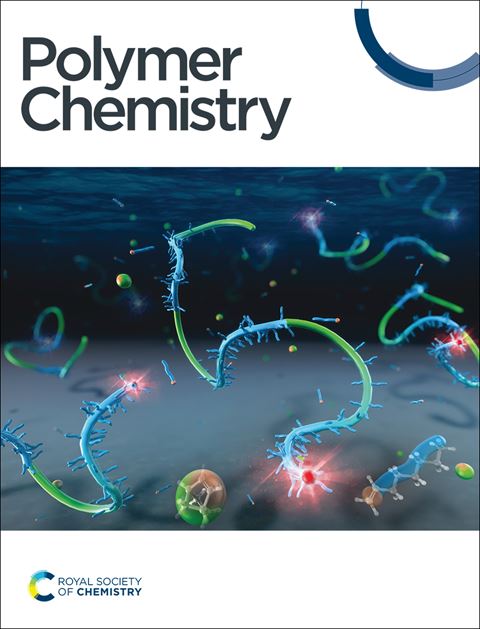天然深共晶:扩展用于 N-异丙基丙烯酰胺热/光诱导聚合的绿色溶剂,实现半天然聚合物可持续生产的关键成分
IF 3.9
2区 化学
Q2 POLYMER SCIENCE
引用次数: 0
摘要
天然深共晶溶剂(NADES)由有机酸、氨基酸和糖等天然成分组成,作为环境友好型溶剂备受关注。在此,我们介绍了天然深共晶单体(NADEMs)的设计与合成。NADEMs是通过N-异丙基丙烯酰胺(NIPAM)与天然固体成分(百里酚、薄荷醇、1-十四烷醇和香豆素)反应制备的,并以NADEM为基础形成了相应的聚合物。最初,我们研究了含有天然化合物的 NADES(百里酚/(±)-薄荷醇:Thy/Men (1/1 和 1/2) 、1-十四醇/(±)-薄荷醇:Tdc/Men (1/2) 和百里酚/香豆素:Thy/Cou (1/1 和 2/1))对固体含酰胺单体 NIPAM 聚合的影响。我们以 NADES 为聚合溶剂,研究了 NIPAM 的热/光诱导自由基聚合和可逆加成-断裂链转移(RAFT)聚合;评估了五种 NADES 的特性和用途。利用 LED-UV 光在 NADES 中对 NIPAM 进行光诱导自由基聚合,可在 1 分钟内实现高单体转化率。光诱导的 RAFT 聚合过程可以很好地控制。此外,还实现了不含挥发性有机溶剂的高效聚合物纯化过程。通过将 NIPAM 与天然化合物混合,开发出了四种基于 NIPAM 的 NADEM。其中,NIPAM/Men 和 NIPAM/Tdc NADEM 在光聚合过程中可在 10 秒内实现定量单体转化,从而获得具有良好机械性能的高分子量产品。NIPAM/Tdc (1/1) 和 NIPAM/Men (1/1) 的可控光诱导 RAFT 聚合得以实现。天然深共晶(NADESs 和 NADEMs)与绿色光诱导聚合的成功结合,拓展了具有独特内在特性和潜在应用的聚合物深共晶。本文章由计算机程序翻译,如有差异,请以英文原文为准。


Natural deep eutectics: expanding green solvents for thermally-/photo-induced polymerization of N-isopropylacrylamide toward key components for sustainable production of semi-natural polymers†
Natural deep eutectic solvents (NADESs), which consist of natural components, including organic acids, amino acids, and sugars, have attracted attention as environmentally friendly solvents. Herein, we describe the design and synthesis of natural deep eutectic monomers (NADEMs), which were prepared by reacting N-isopropylacrylamide (NIPAM) with naturally occurring solid components (thymol, menthol, 1-tetradecanol, and coumarin) and the corresponding NADEM-based polymers. Initially, the effects of NADESs comprising natural compounds (thymol/(±)-menthol: Thy/Men (1/1 and 1/2), 1-tetradecanol/(±)-menthol: Tdc/Men (1/2), and thymol/coumarin: Thy/Cou (1/1 and 2/1)) were investigated on the polymerization of a solid amido-containing monomer, NIPAM. We examined the thermally-/photo-induced free radical and reversible addition–fragmentation chain-transfer (RAFT) polymerization of NIPAM using NADES as a polymerization solvent; the characteristics and usefulness of five NADESs were evaluated. High monomer conversion was accomplished within 1 min by photo-induced free radical polymerization of NIPAM in NADES using LED-UV light. The photo-induced RAFT polymerization could be well controlled. An efficient polymer purification process that excluded volatile organic solvents was also realized. Four NIPAM-based NADEMs were developed by mixing NIPAM and natural compounds. Among them, NIPAM/Men and NIPAM/Tdc NADEMs exhibited quantitative monomer conversion within 10 s during photopolymerization, affording high-molecular-weight products with good mechanical properties. Controlled photo-induced RAFT polymerization of NIPAM/Tdc (1/1) and NIPAM/Men (1/1) could be accomplished. Successful integration of natural deep eutectics (NADESs and NADEMs) and green photo-induced polymerization allows for the expansion of polymeric deep eutectics with unique intrinsic properties and potential applications.
求助全文
通过发布文献求助,成功后即可免费获取论文全文。
去求助
来源期刊

Polymer Chemistry
POLYMER SCIENCE-
CiteScore
8.60
自引率
8.70%
发文量
535
审稿时长
1.7 months
期刊介绍:
Polymer Chemistry welcomes submissions in all areas of polymer science that have a strong focus on macromolecular chemistry. Manuscripts may cover a broad range of fields, yet no direct application focus is required.
 求助内容:
求助内容: 应助结果提醒方式:
应助结果提醒方式:


